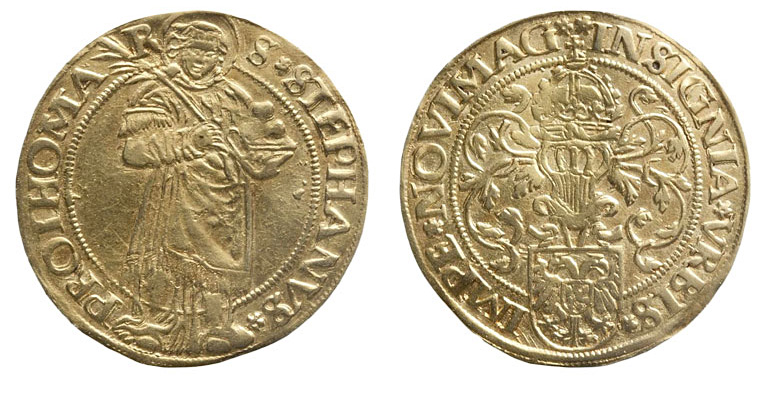The importance of gold ducats increased significantly in the 16th century, due to the expansion of international trade. What’s more, after the fall of Antwerp in 1585, Amsterdam became the most important European trade market. Therefore all the payments in Amsterdam were paid in large amounts of money. By far the best option was to pay with gold ducats, with a value significantly higher than silver coins, including thalers.
In the first half of the 16th century a number of Dutch mints were already minting gold ducats. They were mostly imitations of the well-known Hungarian type, however other types were also minted. Gold ducats from the mints of Batenburg, Hedel, ‘s-Heerenberg, Stevensweert, Nijmegen, Gorinchem, Groninger Ommelanden, Gronsveld, Vianen and Thorn are known. In addition, some so-called ducats were minted in Haarlem, Middelburg and Zierikzee.
A number of gold ducats of the Hungarian type minted in the pre-provincial period have a picture of various Saints (as the only type or one of a few types). We know such ducats from the mints of Batenburg (with St. Victor), Vianen (with St. Henricus), Nijmegen (with St. Stephanus), Hedel (with St. Martin and St. Pancras), ‘s-Heerenberg (with St. Oswald) and Stevensweert (also with St. Oswald).
Examples of the Netherlands ducats from Teylers Museum Coin Cabinet, minted in the pre-provincial period.
In this period a number of various mints were accused of minting debased coins. They were called hagemunten. Also some mintmasters were known for minting debased coins. Peter van Bossenhoven is worth mentioning here. He was accused of counterfeiting coins minted in Gronsveld, Batenburg and Thorn, but he also did it in the mints of Hedel and Stevensweert. In Thorn he was appointed as a mintmaster twice; in 1569 he was once again appointed as the mintmaster of Thorn, only this time he was also appointed as a warden (waardijn). This way he became his own inspector!
A great collection of gold ducats from the pre-provincial period is available for viewing in Teylers Museum. You may see some of them in the photo gallery on this site: TEYLERS MUSEUM NUMISMATIC CABINET.








